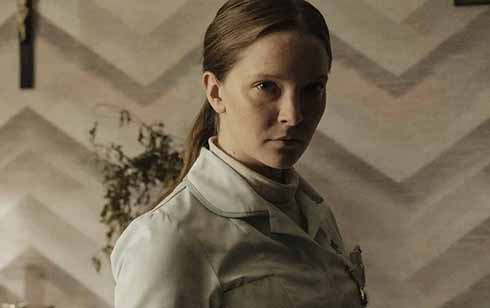 SAINT MAUD, UK, 2019, psychological drama. Starring Morfydd Clark, Jennifer Ehle, Lily Knight, Lily Frazer, Rosie Sansom, Marcus Hutton. Directed by Rose Glass. 84 minutes, Rated MA (Strong themes, violence, sex and coarse language).
SAINT MAUD, UK, 2019, psychological drama. Starring Morfydd Clark, Jennifer Ehle, Lily Knight, Lily Frazer, Rosie Sansom, Marcus Hutton. Directed by Rose Glass. 84 minutes, Rated MA (Strong themes, violence, sex and coarse language).
No, this is not hagiography. But, the central character, Maud, feels she is called to be saintly in her work as a palliative carer.
The trailer seemed to indicate that this is a horror film. There are a few moments which looked like horror film material, but they are a few moments. Rather, this is a psychological study, of a young woman, her nursing experience, her tasks in palliative care, her relationship to her patients/clients.
Our suspicions are awoken when we see Maud (Clark) initially kneeling on the floor, with blood on her hands. (Some explanation for this grizzly scene will be given much later.) But, then we see Maud, in the Yorkshire town of Scarborough, living her dreary life. She has a small flat, in a dingy street. We follow her on her walk to work and watch as she trudges up to a mansion on the top of a high hill. She is welcomed by the departing carer and then goes in to meet her client, Amanda (Ehle), a former choreographer and dancer who is terminally ill,
Maud is devout. Her flat is dotted with crucifix, Marian statues and religious iconography. She says grace before meals and repeatedly makes the sign of the cross.
She is diligent in her work, preparing meals, sharing and supervising physical exercise for Amanda, and even, at Amanda’s invitation, talking about her experience of God.
She shares with a sympathetic Amanda, who calls Maud her little saint, and gives her an inscribed book of the art of William Blake which stirs Maud’s imagination.
Maud disapproves of Amanda’s relationships and visitors, even taking one visitor aside to warn her not to come back and disturb Amanda.
And, there is continual voice-over, Maud’s voice, praying to God, talking to God, God talking back.
We see Maud encountering a friend from past work and find she had another name. We wonder about Maud’s mental state. And, the rest of the film gives quite some cause for our concern. Schizophrenia suggests itself – Maud and her alternate name, alternate behaviour, Maud indulging in severe bodily mortification, burning her hand willingly, nails in her shoe as she walks.
Clark gives a persuasive performance, perhaps reminding the audience of a young Sissy Spacek in look and manner (and, at the end of the film, reminiscent of Sissy Spacek in the climax of Carrie).
While the film’s screenplay leaves it to the audience to assess Maud and what happens to her, the finale, on the beach at Scarborough, reinforces both Maud’s sense of holiness, even martyrdom, as well as destructive madness.
A challenging case study.
Sony Pictures
Released 18 March
Peter Malone MSC is an associate Jesuit Media